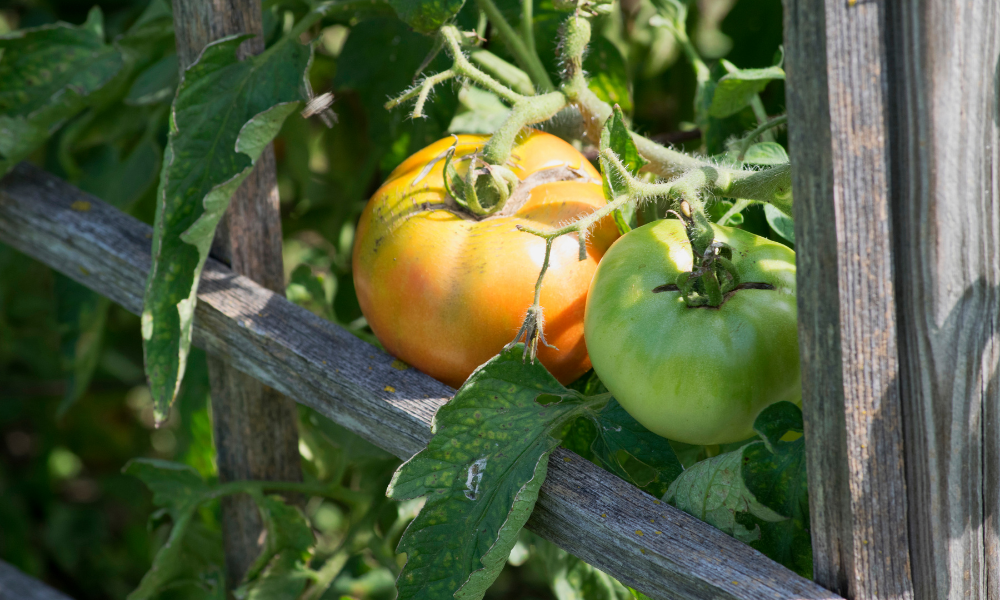No space to expand your garden outward?
Well, how about upward?
You don’t need acres of land to grow your own healthy, pesticide-free food. In fact, you can grow a pantry-full of produce in almost any outdoor space.
Keep reading to learn how to maximize your gardening space with these vertical gardening techniques.
Trellis, Cage, or Stakes
A trellis, cage, or stake allows you to grow more produce in less space by going up instead of out. Vining crops, like pole beans, make great cage-climbing contenders for folks with limited gardening space.
Not only does this gardening method save space, but using a trellis to lift fruit off the ground increases airflow around the fruit. This lowers the risk of fruit developing soil-borne diseases.
Produce that can be grown vertically include:
- Cucumbers
- Melons
- Green Peas and Snow Peas
- Pole Beans
- Summer Squash
- Tomatoes
When planning your planting, put your stakes, trellis, or cage in place before planting your seeds or young plants. Otherwise, you risk damaging the plants’ root systems.
Depending on which produce you grow, you may have to “train” your vines to grow upward by securing vines to your trellis, cage, or stake with zip ties or wire. Some produce, like peas and pole beans, naturally climb, and won’t need as much assistance from you.
Although most trellises used for produce are upright, squash and zucchini plants need more of a flat “tepee effect.” By inserting the metal or wooden stakes in the ground at a 45 degree angle and then securing them together where they meet at the top point, you provide a more secure trellis for the heavy vegetables. Squash will need anywhere from 2 – 4 stakes to trellis squash.
We use wooden stakes to support our tomato plants and fence wire (in a horseshoe shape) to trellis our cucumbers. However, since we grow so much squash for our U-Pick Garden, we don’t trellis our squash.
And remember: ALWAYS, ALWAYS sanitize your supports each year to remove any fungus between planting seasons.
Vertical Pallet Garden
A vertical pallet garden adds whimsy to any wall—and allows you to enjoy a garden, even if you don’t have access to any grassy space. You can plant flowers, succulents, herbs, and even vegetables in your vertical pallet garden.
Building your own vertical pallet garden is inexpensive, requires few supplies, and can easily be completed within the hour. This makes it an easy weekend afternoon project!
To build your vertical pallet garden, you only need a few supplies:
- Wooden palette
- Landscape fabric
- Staple gun
You’ll also need sturdy scissors to cut through the landscape fabric.
IMPORTANT: When choosing your pallet, make sure that they have not been treated with pesticides! Most U.S.-based pallets are heat-treated for pests and are safe to use. Look for the symbol “IPPC” on them to verify.
You can find wooden pallets at your local hardware and gardening stores, as well as any store that orders inventory, like pet stores and grocery stores. You’ll have a better chance at sourcing from local small businesses rather than larger chain stores. The bigger box stores likely already have a system in place to remove their wooden pallets.
Since my husband, Olin, was in construction for years, he has sourced pallets from building sites that he has visited. If you source from a building site, you must check with the contractor FIRST to make sure you are allowed to do so.
Click here for instructions on building your vertical pallet garden.
Lasagna Gardening
While not technically a vertical gardening option, a lasagna garden paves the way for growing a garden—on pavement. (Yep, you read that right.) So we had to include this growing method for our apartment-dwelling friends!
Lasagna gardening opens the door to rooftop gardens and balcony blooms.
But what exactly is it?
Lasagna gardening, also known as sheet mulching, is a method of creating a garden that mimics the decomposition of natural soil without actually digging into the soil itself. Sheet mulching—like lasagna—consists of three layers:
- Cardboard base
- Water-absorbent materials
- Compost
The base layers choke out any weeds (if you are building your lasagna garden on soil), while the top layer allows for fertile soil for planting. Because a lasagna garden is its own mini-ecosystem, this method can be used to create a garden just about anywhere.
Learn more about creating your own lasagna garden.
We’re here to help.
Do you have questions about gardening or sustainable living? We’re here to be your accessible experts! You can email me (Leigh) your questions at stoneycreekfarmtennessee@gmail.com.


